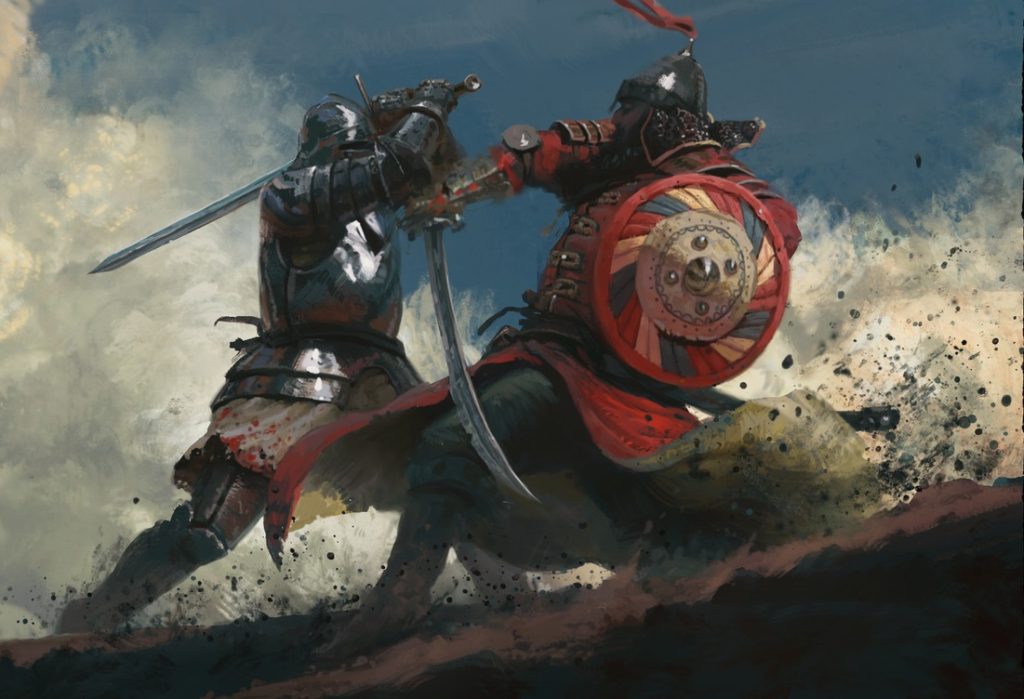Blogger ate a draft of this post and I'm not pleased about it. I realize I've posted ideas along these lines before, but here are the versions I like the best now.
 |
| Artist: Simon Gocal |
Action
Surprised figures do not move or act during the first round that they join combat. Otherwise, the adventurers and their enemies move and act in alternate phases:
- Enemies move
- Adventurers move & act
- Enemies act
- Attacks are resolved
A figure's movement ends if they enter the reach of a foe that can act.
If they start within its reach, their movement is limited to one inch.
A figure's movement depends on the load they are carrying. A burdened figure may move twice their Size (in inches, scale TBD), one in heavy kit may move three times their Size and one in light kit may move four times their Size. If a burdened figure moves more than their Size, on an unburdened one twice their Size, they may not act.
A figure may drop what they are holding, or drop into a kneel (-1 Size) or to the ground (-2 Size) freely. Instead of movement, a figure may:
- Concentrate on magic
- Draw or stow an item
- Open or close a door
- Stand from a kneel
- Take aim
Or similar things; otherwise, these are all actions. Standing from the ground allows only one inch of movement and no other actions.
Attacking
An attacker states their aim, for example, draw out, disarm, push back, restrain, seize, throw or wound. Then, they make their roll and add +1 for every 4HP they currently have. Subtract 4 if they are fighting in an awkward or unfamiliar manner. Then apply situational modifiers:
- In hand-to-hand, apply the attacker's Strength modifier. Add +2 if the target was attacked by another this round.
- Fighting at reach, apply the attacker's Dexterity modifier. Add +2 if the target entered the attacker's reach this round.
- Shooting at range, apply the attacker's Intelligence modifier. Add +2 if the target has not moved this round.
Attacks at range are resolved first, followed by attacks at reach in descending order of reach and finally by hand-to-hand attacks.
An attack succeeds if the modified roll is at least equal to the target's defense. This has two components. A figure's dodge is 3 plus their Wisdom modifier. A figure's protection is 3, plus one for every layers of armor, source of cover or increment of the target's Size (in inches) between the attacker and target.
- When taking cover or other defensive action, defense is dodge + three times protection.
- Otherwise, when able to act, defense is dodge + two times protection.
- Otherwise, defense is two times protection.
If the attack is successful, the attacker rolls damage based on their own Size.
| Example | Size | Die Type |
| cat | 0 | d2 |
| fairy, monkey | 1 | d2 |
| dog, elf | 2 | d4 |
| deer, man | 3 | d6 |
| horse, thark | 4 | d8 |
| ogre, rhinoceros | 5 | d10 |
| elephant, giant | 6 | d12 |
| dragon | 7 | d20 |
The target may choose to either lose that many HP (if they have that many) or accept the aim of the attack.
Odd attack rolls fail against targets that are concealed from their attackers. If the target is totally concealed, the attacker must have some way of discerning their exact position before attempting an attack in the first place.
Wounding
When a figure is wounded, the severity of the wound depends on how much the damage exceeds their current HP. For these purposes, subtract 2 from the damage of bare fists or feet. A wounded figure makes a saving throw, adding their Constitution modifier.
| Excess | Wound | DC | Success | Failure |
| 2 or less | Light | 12 | Fine | Unconscious |
| 3 to 5 | Serious | 15 | Unconscious | Dying |
| 6 or more | Critical | 18 | Dying | Dead |
A dying character will die if their wound is not treated within a few minutes. An unconscious character may make another save within a few minutes to come to, otherwise they remain out for a few hours.
No comments:
Post a Comment